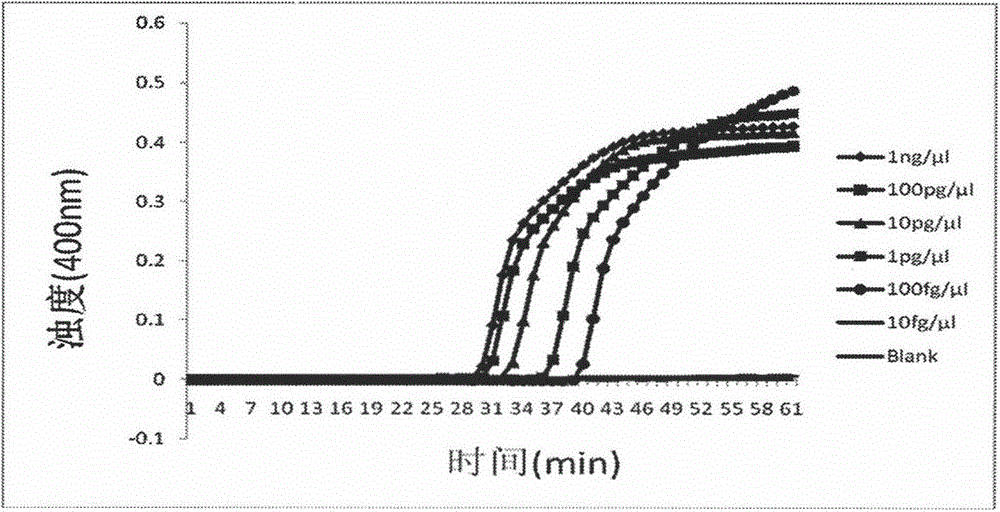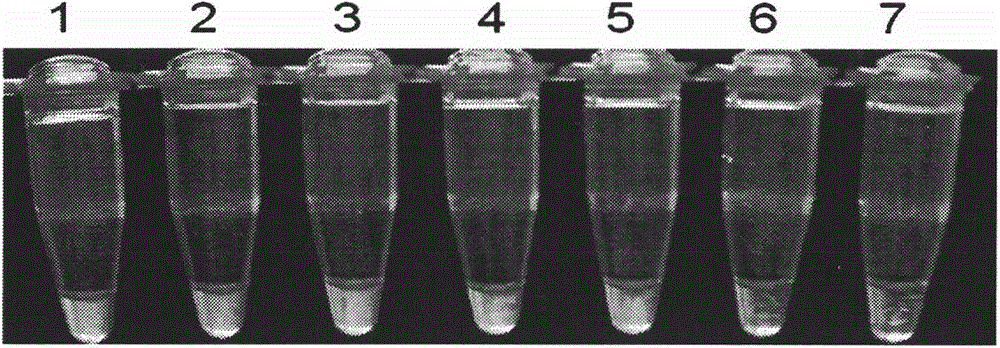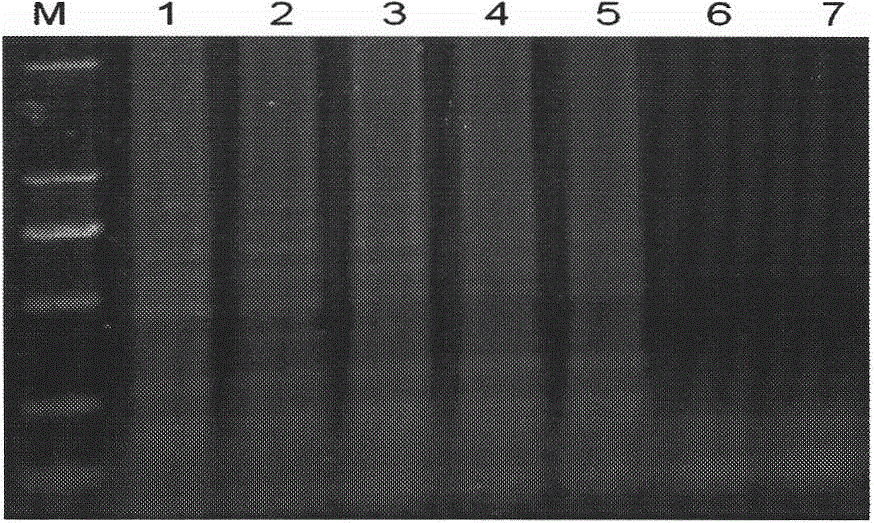Method for detection of turnip mosaic virus using reverse transcription loop-mediated isothermal amplification technique
A turnip mosaic virus and loop-mediated isothermal technology, applied in the field of plant virology, can solve the problems of low accuracy, long test period and low sensitivity, achieve high specificity, reduce detection cost, and improve detection efficiency. Effect
- Summary
- Abstract
- Description
- Claims
- Application Information
AI Technical Summary
Problems solved by technology
Method used
Image
Examples
Embodiment 1
[0051] 1. Primer Design
[0052] First, the inventor downloaded the whole genome sequence of TUMBV from NCBI, and designed multiple sets of primers using Primer4.0 (http: / / primerexplorer.jp / e / v4_manual / index.html), and then according to the The primers were selected based on comprehensive factors such as the conservation of the sequence region, the hairpin structure of the primer, the GC content of the dimer and the Tm value. The primer set has 4 primers, including 2 outer primers (F3 and B3) and 2 inner primers (FIP and BIP). The primers refer to SEQ ID NO.1-4. Primers for RT-PCR, the present invention uses the primers of Zhuang Mu et al., refer to SEQ ID NO.5-6. See Table 1 for information on all primers.
[0053] The information of the primer sequence SEQ ID NO.1-4 in table 1:
[0054]
[0055] 2. RNA extraction
[0056] Using the polysaccharide polyphenol plant total RNA rapid extraction kit (centrifugal column) (Bioteke), according to the operating instructions, e...
Embodiment 2
[0060] Example 2 , RT-PCR and RT-LAMP detection sensitivity comparison:
[0061] In order to compare the sensitivity of RT-LAMP and RT-PCR, the present invention uses a pair of specific primers containing TuMVCP gene by Zhuang Mu et al.
[0062] The RT-PCR process is as follows:
[0063] The RT-PCR reaction system is 12.5 μl, including 3.5 μl DEPC-treated water, 0.5 μl downstream primers, and 1 μl ASGV RNA, then bathed in 70°C water for 5 minutes, then placed on ice for 5 minutes, then added 1.75 μl DEPC-treated water, 2.5 μl dNTPs (10mM) , 2.5μl 5×M-MLV buffer (50mM Tris-HCL, 75mM KCL, 3mM MgCl 2 , 10 mM DTT), 0.5 μl M-MLV reverse transcriptase, 0.25 μl RNase inhibitor, then react at 42° C. for 1 h, and then react at 95° C. for 5 minutes. Take 2 μl of the reaction product for PCR reaction. For the operation method, refer to the method of Zhuang Mu et al. [1] .
[0064] Then the RT-PCR amplified product was recovered by Bioteke Gel Extraction Kit and connected to pMD18-T...
Embodiment 3
[0068] Example 3 , RT-PCR and RT-LAMP to detect field samples:
[0069] Several field samples were detected by RT-PCR and RT-LAMP respectively, and the results of the two methods were consistent.
[0070] The RT-LAMP detection method does not require expensive instruments and equipment, the operation procedure is simple, and it has the characteristics of fast, efficient, high specificity, and high sensitivity. Its application range is becoming wider and wider, and it has played a great role in the detection of pathogenic microorganisms. Advantages, and successfully applied in the related research of tumor genes. The RT-LAMP method described in this experiment and the RT-PCR method were used to simultaneously detect multiple samples of diseased plants such as rapeseed, Chinese cabbage, and cauliflower, and the results were consistent. It is obvious that the RT-LAMP method can save a lot of time, and easy to use.
[0071] In a word, the present invention establishes a set of...
PUM
 Login to View More
Login to View More Abstract
Description
Claims
Application Information
 Login to View More
Login to View More - R&D
- Intellectual Property
- Life Sciences
- Materials
- Tech Scout
- Unparalleled Data Quality
- Higher Quality Content
- 60% Fewer Hallucinations
Browse by: Latest US Patents, China's latest patents, Technical Efficacy Thesaurus, Application Domain, Technology Topic, Popular Technical Reports.
© 2025 PatSnap. All rights reserved.Legal|Privacy policy|Modern Slavery Act Transparency Statement|Sitemap|About US| Contact US: help@patsnap.com



